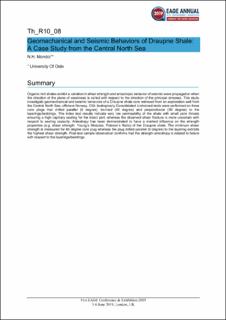Geomechanical and Seismic Behaviors of Draupne Shale: A Case Study from the Central North Sea
Chapter
Published version
Permanent lenke
https://hdl.handle.net/11250/2647350Utgivelsesdato
2019Metadata
Vis full innførselSamlinger
- NGI articles [1061]
Sammendrag
Organic-rich shales exhibit a variation in shear strength and anisotropic behavior of seismic wave propagation when the direction of the plane of weakness is varied with respect to the direction of the principal stresses. This study investigats geomechanical and seismic behaviors of a Draupne shale core retrieved from an exploration well from the Central North Sea, offshore Norway. CIU- Isotropically Consolidated Undrained-tests were performed on three core plugs that drilled parallel (0 degree), inclined (45 degree) and perpendicular (90 degree) to the layerings/beddings. The index test results indicate very low permeability of the shale with small pore throats ensuring a high capillary sealing for the intact part, whereas the observed shear fracture is more uncertain with respect to sealing capacity. Anisotropy has been demonstrated to have a marked influence on the strength properties (e.g. shear strength, Young's Modulus, Poisson's Ratio) of the Draupne shale. The minimum shear strength is measured for 45 degree core plug whereas the plug drilled parallel (0 degree) to the layering exhibits the highest shear strength. Post-test sample observation confirms that the strength anisotropy is related to failure with respect to the layerings/beddings.
